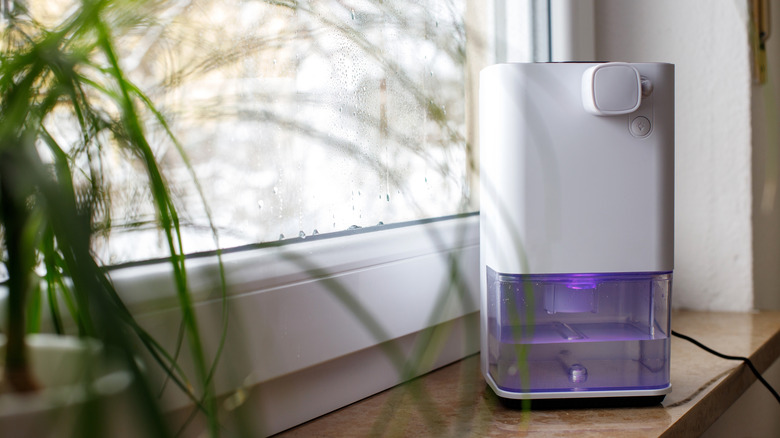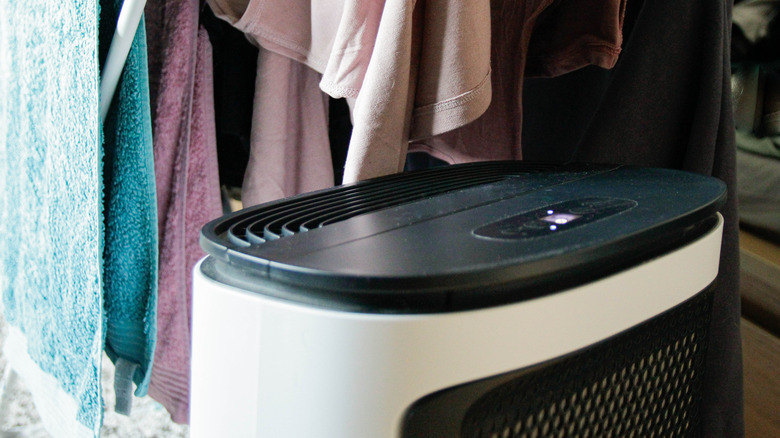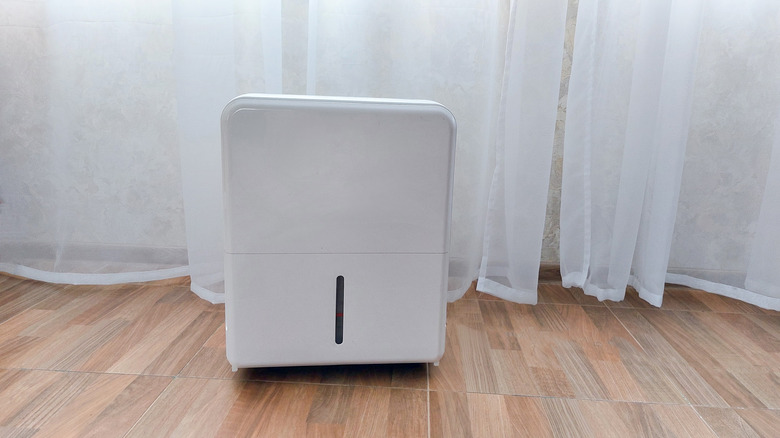Avoid These Common Mistakes When Dehumidifying Your Home For Maximum Efficiency
Dehumidifiers can be an invaluable tool for ridding your home of excess moisture. Overly humid conditions can contribute to the formation of mold and mildew and can even exacerbate asthma and allergies. One little machine can mitigate this potential and help your home feel much more light and airy. However, there are a few common mistakes people make when it's time to dehumidify their homes. According to experts, these mistakes include buying a device that's too small for your space and improperly placing your machine to ensure you're getting the most out of it.
Noel Gillis from Home Mechanics, a licensed HVAC Contractor in the Boston area, spoke exclusively with House Digest about the pitfalls and benefits of using a dehumidifier in your home. One of the biggest mistakes he sees homeowners make is failing to choose the right size dehumidifier for their space. Although going with a smaller unit may seem like a way to save money, it could end up hurting you in the long run, and there are also significant downsides to choosing a dehumidifier that's too large. "If it's too small, it won't be able to handle the humidity, and if it's too large, you're just wasting energy and putting unnecessary wear and tear on the unit," Gillis said. "It's really important to match the capacity of the dehumidifier to the size of the room and the level of moisture you're dealing with."
What to avoid when placing a dehumidifier
Choosing the right humidifier is the first step, but proper placement is another battle that Noel Gillis sees homeowners struggling with. "People often tuck their dehumidifiers into corners or against walls thinking it's out of the way, but [this] actually restricts airflow," he told House Digest exclusively. "For a dehumidifier to work effectively, it needs plenty of space around it for air to circulate." For this reason, Gillis recommended placing the unit "in a central spot where it's not blocked by walls, furniture, or curtains." He also suggested that in basements or laundry rooms, dehumidifiers should be positioned "near the source of the moisture, such as a laundry area or a leak." While your dehumidifier may not exactly complement your home decor, good air quality is more important than hiding your device.
Gillis also stressed the importance of informing yourself before purchasing a dehumidifier. "Not all dehumidifiers are the same, so people need to research before they buy one," he said. "Know the size of the space you're working with, and measure the humidity levels using a hygrometer. This will help you select the right model for your needs." Gillis pointed out that knowing your humidity levels will help you decide between a tank-based model and one with a drain feature. "If you're dealing with a high-humidity area like a basement, it's worth investing in a dehumidifier with a continuous drain option," he said. "That way, you're not constantly emptying the tank." The best dehumidifiers for basements will even have features like a timer or sleep mode, which is convenient if your basement has a bedroom.
How to place your dehumidifier for maximum effectiveness
Noel Gillis also had several helpful suggestions for getting the most out of your dehumidifier in his exclusive sitdown with House Digest. "For maximum efficiency, start by placing the dehumidifier in the dampest [areas] of your home, [which are] usually basements, bathrooms, or laundry rooms," he said. "Make sure there's plenty of space around the unit so it can pull in and release air without obstruction. Avoid placing it right next to walls or furniture."
Once things are up and running, ensure that you're using your machine at optimal times. "Run the dehumidifier during peak humidity times, like in the evenings or during damp weather," Gillis suggested. "Also, keep in mind that these units work best in temperatures above 65 degrees Fahrenheit. If you're dealing with a cooler area, like an unheated basement, consider a desiccant dehumidifier that's designed for those conditions." Finally, Gillis said you should maintain your dehumidifier regularly to ensure it's clean and functional: "Clean the filters every two to three weeks and replace them every three to six months, depending on usage and the manufacturer's recommendations," he said. "It's also a good idea to check for any clogs in the drainage system and to clean the coils periodically to keep the unit running efficiently."


